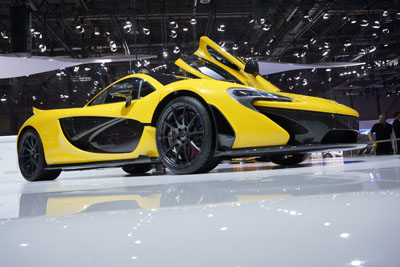McLaren Plug-in Hybrid P1 2013
February 26th 2013 - Details of the McLaren Plug-in Hybrid P1 supercar have just been released by the manufacturer. The McLaren P1 has been presented in a styling preview at the 2012 Paris Mondial Motor Show and is to be officially introduced at 2013 Geneva Auto Show. The race-inspired Instant Power Assist System (IPAS) gives the McLaren P1 astonishing performance. Zero to 100 kph (62 mph) will take less than 3 seconds, zero to 200 kph (124 mph) under 7 seconds, and zero to 300 kph (186 mph) will be achieved in no more than 17 seconds. Putting into perspective, that is 5 seconds faster than the legendary McLaren F1 road car. Top speed is electronically limited to 350 kph (217, 5 mph). McLaren has been engaging with potential customers actively in the last few months to get their views about the car styling of the McLaren P1. Their unanimous verdict on the styling was not to change the car presented mast September in Paris. So unusually, the McLaren P1 has translated to production form with very little change. In fact just one change occurred; that is the addition of LTR ducts ahead of each of the front wheels to further enhance air cooling and optimise downforce. McLaren has closely monitored demand so as to maintain exclusively, and announced a production number of just 375 units – a figure that will ensure the McLaren P1 will remain a rarity and, if spotted on the road, an unforgettable sight. McLaren has also announced that the car will cost from £866,000 on the road with a specification that fully equips the car for both road and track use. The McLaren P1 will have the combined force of two highly-efficient powerplants, offering the optimum mix of superb throttle response, day-to-day drivability and top speed. A mid-mounted 3.8-litre twin-turbo V8 petrol engine and a highly effective electric motor give a combined output of 916PS (903 bhp) and a maximum torque figure of 900Nm, ensuring instantaneous throttle response through the rev range, more akin to a naturally aspirated engine. Emissions of less than 200g/km on the combined cycle are reduced to zero in full electric drive mode, while the Formula 1-derived DRS and IPAS technologies offer an increase in straight-line speed and an instant boost of power.
The 3.8-litre twin-turbo V8 petrol engine in the McLaren P1 is a new version of the familiar M838T unit, that has been significantly upgraded to optimise cooling and durability under the higher loads. The engine block has a unique casting to incorporate the electric motor. The petrol engine produces 737PS (727 bhp) at 7,500rpm, and 720Nm of torque from 4,000rpm. The lightweight electric motor, developed by the McLaren Electronics arm of the Group, produces 179PS (176 bhp), and is unique to the McLaren P1. The motor produces maximum torque of 260Nm instantly from a standstill, greatly increasing the throttle response of the McLaren P1, and peak combined torque of 900Nm is delivered from just 4,000 rpm. In addition to this, the McLaren-developed ‘boost’ system, IPAS, provides up to 179PS instantly. The instant response of the electric motor provides a sharper throttle response more associated with a normally aspirated engine, and the significantly enhanced air-charging system enables the McLaren P1 to have more top-end power – the perfect combination for high performance. The electric motor is mounted directly onto the engine, and all drive is channelled through the dual-clutch seven-speed gearbox to drive the rear wheels. Thus, the electric motor and 3.8-litre twin-turbo V8 petrol engine work seamlessly together, providing more than just added ultimate power and torque. In addition to the obsessive weight-saving measures demonstrated throughout the McLaren P1, so too is the optimisation of usable energy. When off-throttle the electric motor provides additional drag torque, recovering energy to the battery that would otherwise be lost to the brakes. The McLaren P1 can be driven in a variety of modes, powered by the engine and electric motor together, or solely by the electric motor. This ensures versatility and ease of transportation, allows use in low emission zones and residential driving is optimised with near-silent running. The power available via the petrol engine and electric motor is further enhanced on the McLaren P1 through two steering wheel-mounted buttons which activate the DRS (Drag Reduction System) and IPAS (Instant Power Assist System). The high power density has been achieved through a combination of high power cells, low pack weight and an innovative cooling system. The battery weighs just 96kg, and is mounted onto the under-body of the high-strength Formula 1-grade carbon fibre MonoCage chassis, which seals the unit in the vehicle, thus avoiding the added weight of any unnecessary battery packaging. The tyres fitted to the McLaren P1™ are specially developed P Zero Corsas, which have been developed with McLaren’s technology partner, Pirelli. The team at Pirelli has been involved throughout the entire development programme, and this has seen the tyre testing phase integrated into the schedule, as a key performance component. The final compound and construction has been developed and optimised during testing, and the end result is a tyre that is finely tuned specifically to the performance and handling characteristics. To rein in the power produced by the twin powerplants, the McLaren P1™ is designed to offer braking performance more associated with a GT3 or sports racing car. Developed by McLaren’s Formula 1 partner Akebono, the system features a new type of carbon ceramic disc, which has previously seen service in space, but never before used on a road car. Stronger than conventional carbon ceramic, the material dissipates heat more effectively, giving the highly efficient braking system exceptional stopping and cooling capability. The system also boasts significantly reduced weight, and a bespoke ceramic layer coats both friction surfaces to give an attractive mirrored finish. Wallpapers : McLaren Plug-in Hybrid P1 2013 (click on image to enlarge)
|
|||||||||||||||||
|---|---|---|---|---|---|---|---|---|---|---|---|---|---|---|---|---|---|
|
||||||||||||||



















